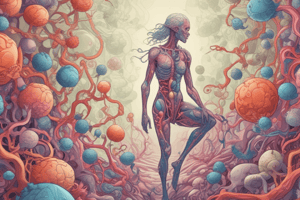Podcast
Questions and Answers
What is the function of the endocrine system?
What is the function of the endocrine system?
- Exchanging gases in the alveoli
- Creating and storing urine
- Regulating growth and development (correct)
- Filtering waste from the bloodstream
Where does the process of food consumption start?
Where does the process of food consumption start?
- Nostrils (correct)
- Trachea
- Stomach
- Alveoli
Which organ is responsible for filtering wastes out of the bloodstream?
Which organ is responsible for filtering wastes out of the bloodstream?
- Lungs
- Brain
- Liver
- Kidneys (correct)
What is the main function of alveoli in the respiratory system?
What is the main function of alveoli in the respiratory system?
Which system is responsible for maintaining homeostasis in the body?
Which system is responsible for maintaining homeostasis in the body?
What is essential for understanding human anatomy according to the text?
What is essential for understanding human anatomy according to the text?
What type of tissue allows movement in the body?
What type of tissue allows movement in the body?
Which organ is involved in food processing within the digestive system?
Which organ is involved in food processing within the digestive system?
What is the main function of the Circulatory System?
What is the main function of the Circulatory System?
Which tissue is responsible for communication within the body?
Which tissue is responsible for communication within the body?
In the Respiratory System, what is exchanged between the environment and internal circulation?
In the Respiratory System, what is exchanged between the environment and internal circulation?
Which system removes carbon dioxide waste products from cellular respiration?
Which system removes carbon dioxide waste products from cellular respiration?
Flashcards are hidden until you start studying
Study Notes
Welcome to a journey through human anatomy! This fascinating field explores the structure of our bodies and how they function together to keep us alive and well. Let's dive into some key aspects of this complex system.
Tissues and Organs
At the most basic level, anatomical structures can be divided into several types of tissues. These include connective tissue like bones, cartilage, and skin; muscle tissue which allows movement; nervous tissue consisting of neurons used for communication within the body; epithelial tissue found on surfaces such as skin; and glandular tissue involved with secretion processes.
Organs serve specific functions within their systems. For example, organs in the digestive system like the stomach and intestines handle food processing while those in the respiratory system, such as lungs, facilitate gas exchange between the air we breathe and blood circulating throughout our bodies.
Systems
The major systems make up bigger parts of the overall body organization. Some notable ones include:
-
Circulatory System: This system transports oxygen from your lungs to all cells needing it via red blood cells. It also removes carbon dioxide waste products produced by cells during cellular respiration.
-
Respiratory System: As mentioned earlier, this system facilitates the process of exchanging oxygen and carbon dioxide between the environment and internal circulation. Air enters through nostrils, passes down trachea tubes connected to bronchi and eventually reaches alveoli where gases are exchanged.
-
Digestive System: Food consumption starts here, beginning with chewing followed by swallowing - both processes help break down large pieces of food into smaller chunks called chyme before passing onto the stomach.
-
Urinary System: Kidneys filter wastes out of bloodstream creating urine which is transported through ureters to bladder storage until eliminated from body.
-
Endocrine System: Hormones play crucial roles controlling various bodily activities including growth & development, metabolism, sexual function reproduction etc., regulated by endocrine glands.
Each organ contributes significantly towards keeping these systems functioning smoothly, ensuring homeostasis—the state of equilibrium inside one's body.
In summary, understanding human anatomy involves exploring its smallest components, comprehending their working relationships, assembling them hierarchically, and appreciating their collective behavior over time under diverse conditions. From cells and tissues forming organs, these organs interact within multiple integrated systems to sustain life. Learning more about this intricate web will give you better insight into maintaining optimal health.
Studying That Suits You
Use AI to generate personalized quizzes and flashcards to suit your learning preferences.




